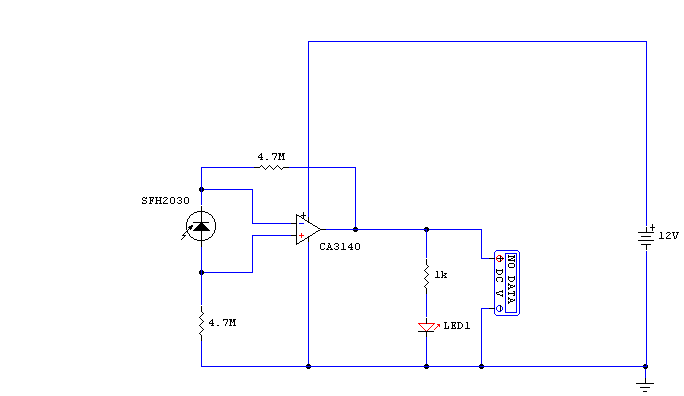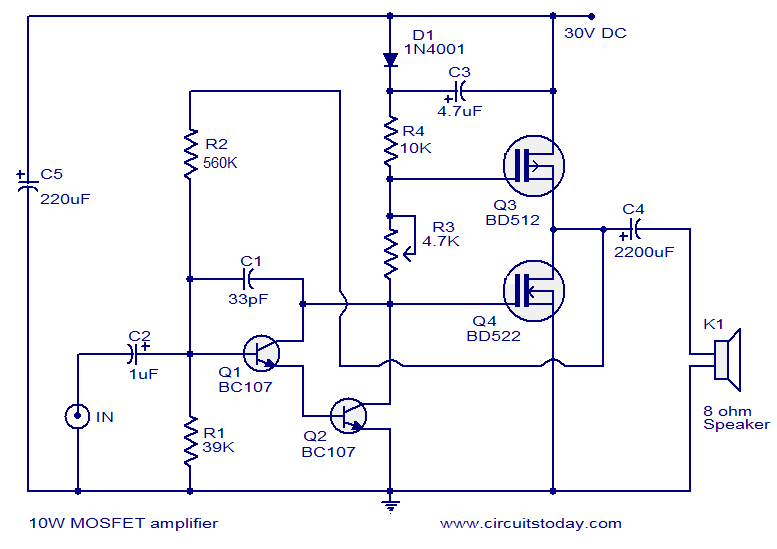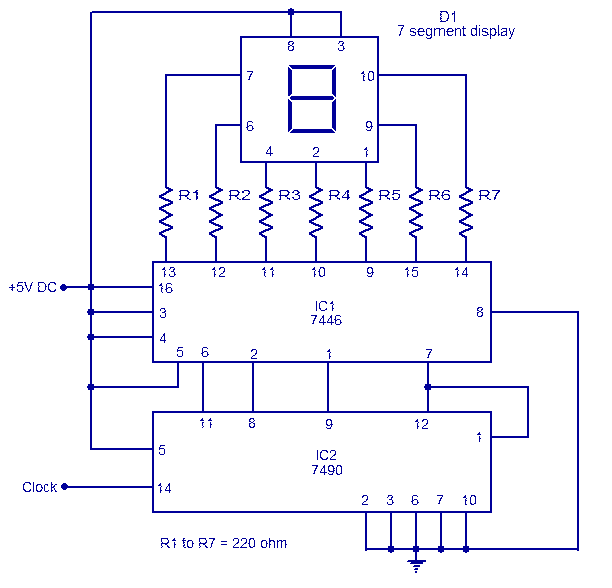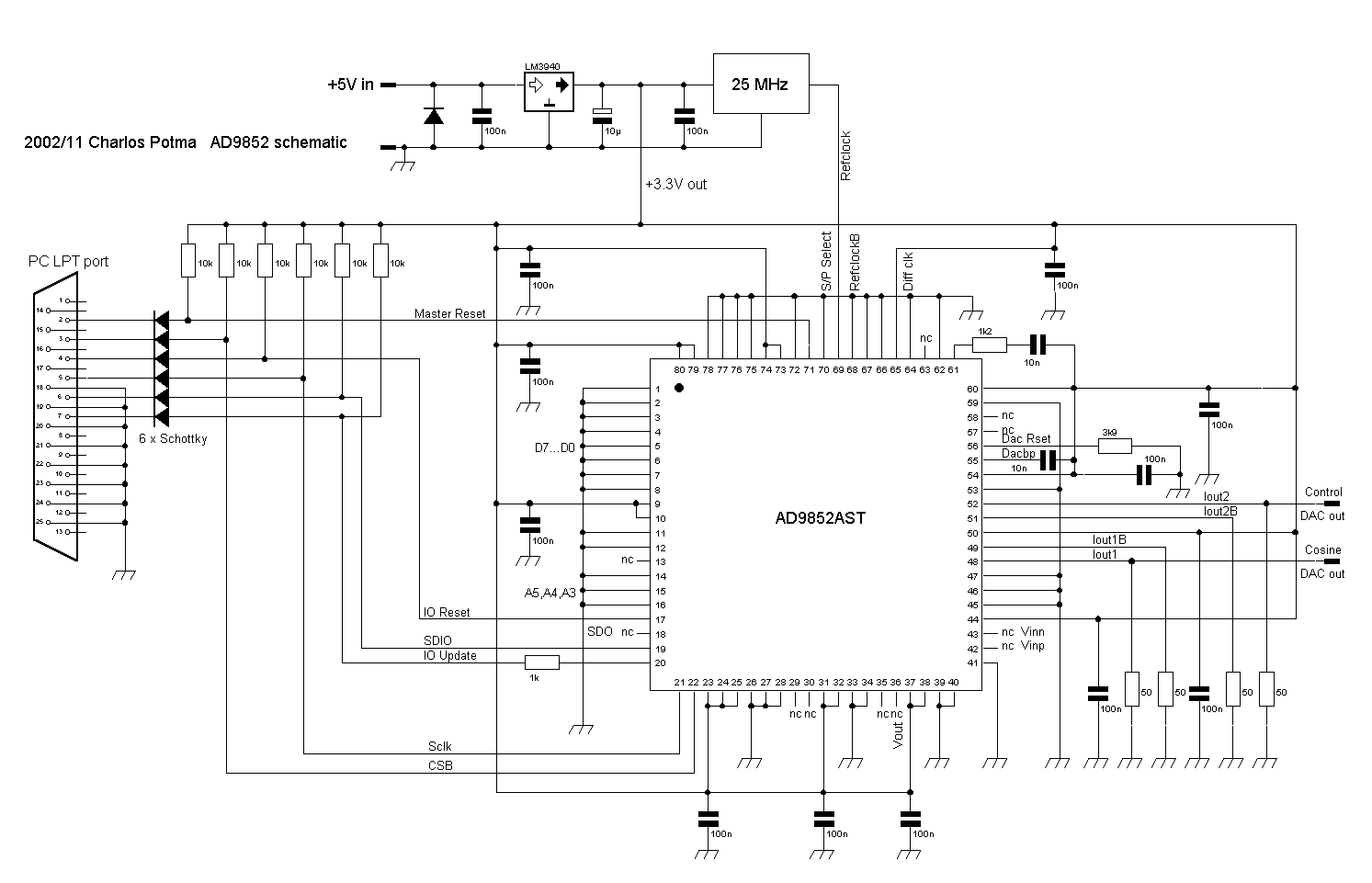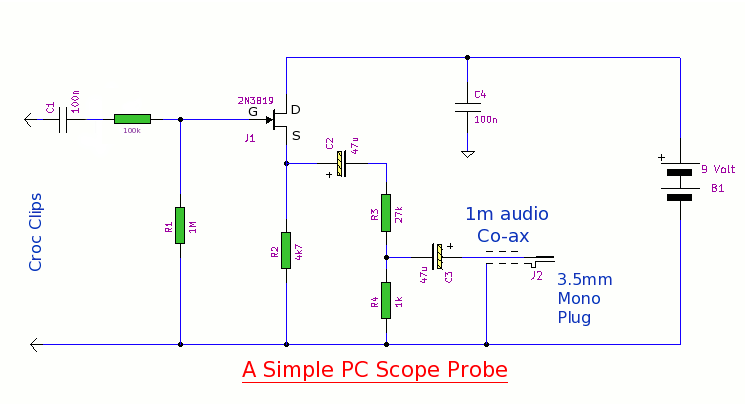
AF counter circuits
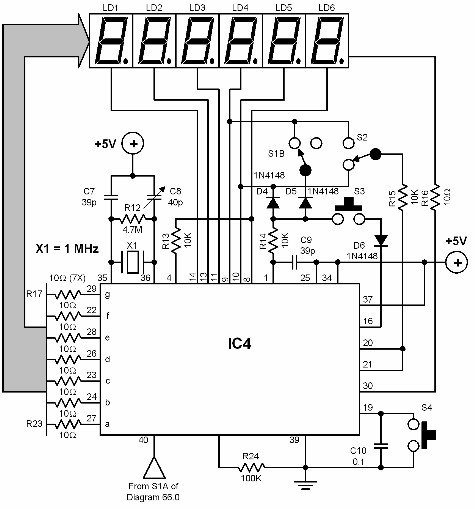
A digital audio frequency (AF) counter can be constructed using a minimal number of components by employing a single 7226B integrated circuit (IC) from Intensil, as depicted in the accompanying diagram. This circuit has an upper frequency limit of 9 MHz. The primary functions of the frequency counter include pulse processing, multiplying, counting with a timebase, and display. The input signal is converted into a square wave pulse by the input circuitry, which is designed to withstand voltages of up to 50 Vrms and has an impedance of approximately 2 megaohms. The signal is then multiplied by a factor of 100. The counting operation is performed by the 7226B IC, which incorporates various functional blocks: an oscillator with a timebase, gating circuitry, counter stages, and a driver for a 7-segment display along with a multiplexer. Switch S1 allows the user to select between the original frequency and the multiplied frequency. By multiplying the input signal by 100, the counter can display frequencies ranging from 5 Hz to 5 kHz. Switch S2 is used to select the measuring range, while switch S3 functions as the power supply switch.
The digital audio frequency counter utilizing the 7226B IC is a compact and efficient solution for frequency measurement in the audio range. The circuit begins with the input stage, which is responsible for converting incoming analog signals into square wave pulses suitable for processing. This stage is crucial for ensuring accurate frequency measurements, as it provides a clean and stable signal for further processing. The input circuitry's high voltage protection and high impedance ensure that it can handle a variety of input conditions without damaging the device or affecting measurement accuracy.
The multiplication stage, which boosts the frequency range by a factor of 100, is particularly useful for displaying lower frequency signals more conveniently. This feature allows users to accurately measure and display frequencies from 5 Hz to 5 kHz, thereby expanding the versatility of the counter. The 7226B IC integrates essential components such as the oscillator, which provides a stable timebase for counting, and the gating circuitry, which controls the timing of the counting process.
The counter stages within the IC are designed to tally the incoming pulses generated by the input circuitry, allowing for precise frequency measurements. The results are then sent to the display driver, which manages the output to the 7-segment display. This display provides a clear and easily readable indication of the measured frequency, with the option to toggle between the original and multiplied frequencies using switch S1.
Overall, the design of this digital AF counter emphasizes simplicity and efficiency, making it an ideal choice for applications requiring accurate audio frequency measurements. The inclusion of multiple switches for range selection and power management further enhances user control over the operation of the device, ensuring that it meets a wide range of measurement needs.A digital AF (audio frequency) counter can be constructed with only few components by using a single 7226B IC from Intensil as shown in the diagram. The upper frequency limit of this circuit is 9 MHz. The four important functions in the frequency counter are: pulse processing, multipying, counting with timebase, and display.
The input signal is co nverted to a squarewave pulse by the input circuitry. The input circuitry is protected up to 50 Vrms. Its impedance is around 2 megaohms. The signal is then multiplied by a factor of 100. The counting process is done by the IC 7226B. This IC integrates the following circuits: oscillator with timebase; gating circuitry; counter stages; and a 7-segment display driver with multiplexer. Switch S1 enables one to choose between the original frequency or the one multiplied by 100. Multiplying the input by 100 enables the frequency range 5 Hz to 5 kHz to be displayed. S2 selects the measuring range while S3 is the power supply switch. 🔗 External reference
The digital audio frequency counter utilizing the 7226B IC is a compact and efficient solution for frequency measurement in the audio range. The circuit begins with the input stage, which is responsible for converting incoming analog signals into square wave pulses suitable for processing. This stage is crucial for ensuring accurate frequency measurements, as it provides a clean and stable signal for further processing. The input circuitry's high voltage protection and high impedance ensure that it can handle a variety of input conditions without damaging the device or affecting measurement accuracy.
The multiplication stage, which boosts the frequency range by a factor of 100, is particularly useful for displaying lower frequency signals more conveniently. This feature allows users to accurately measure and display frequencies from 5 Hz to 5 kHz, thereby expanding the versatility of the counter. The 7226B IC integrates essential components such as the oscillator, which provides a stable timebase for counting, and the gating circuitry, which controls the timing of the counting process.
The counter stages within the IC are designed to tally the incoming pulses generated by the input circuitry, allowing for precise frequency measurements. The results are then sent to the display driver, which manages the output to the 7-segment display. This display provides a clear and easily readable indication of the measured frequency, with the option to toggle between the original and multiplied frequencies using switch S1.
Overall, the design of this digital AF counter emphasizes simplicity and efficiency, making it an ideal choice for applications requiring accurate audio frequency measurements. The inclusion of multiple switches for range selection and power management further enhances user control over the operation of the device, ensuring that it meets a wide range of measurement needs.A digital AF (audio frequency) counter can be constructed with only few components by using a single 7226B IC from Intensil as shown in the diagram. The upper frequency limit of this circuit is 9 MHz. The four important functions in the frequency counter are: pulse processing, multipying, counting with timebase, and display.
The input signal is co nverted to a squarewave pulse by the input circuitry. The input circuitry is protected up to 50 Vrms. Its impedance is around 2 megaohms. The signal is then multiplied by a factor of 100. The counting process is done by the IC 7226B. This IC integrates the following circuits: oscillator with timebase; gating circuitry; counter stages; and a 7-segment display driver with multiplexer. Switch S1 enables one to choose between the original frequency or the one multiplied by 100. Multiplying the input by 100 enables the frequency range 5 Hz to 5 kHz to be displayed. S2 selects the measuring range while S3 is the power supply switch. 🔗 External reference
Warning: include(partials/cookie-banner.php): Failed to open stream: Permission denied in /var/www/html/nextgr/view-circuit.php on line 713
Warning: include(): Failed opening 'partials/cookie-banner.php' for inclusion (include_path='.:/usr/share/php') in /var/www/html/nextgr/view-circuit.php on line 713
